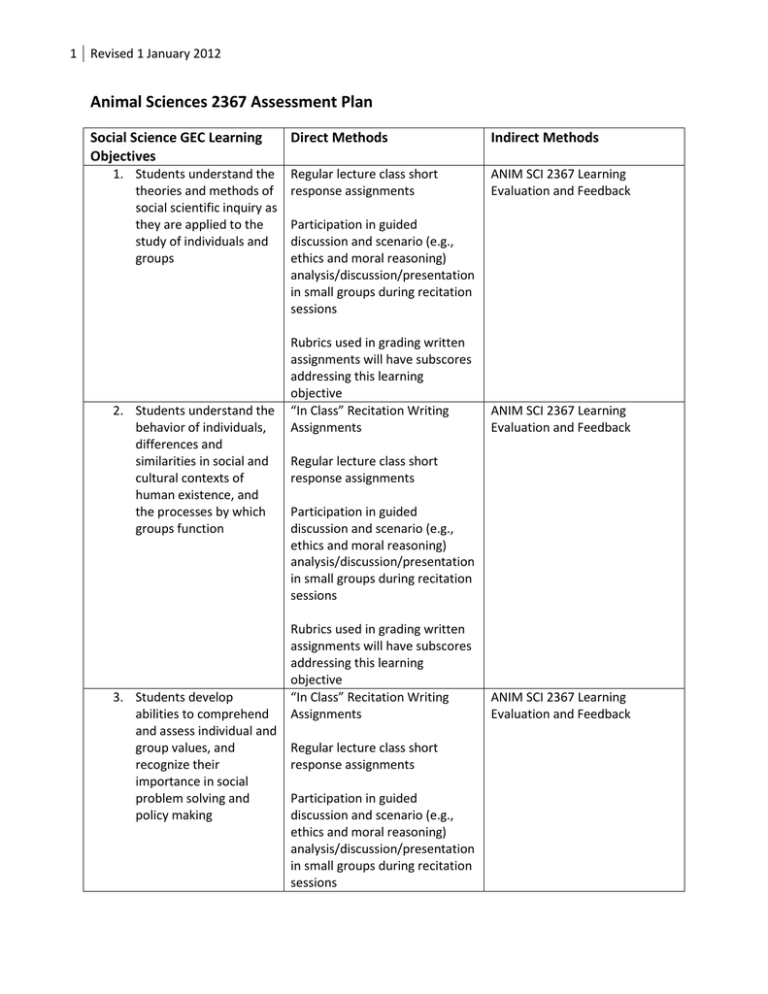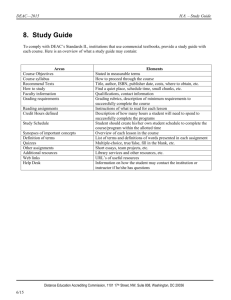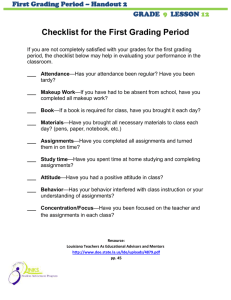Animal Sciences 2367 AssessmentPlan response to ASCC Art and
advertisement

1 Revised 1 January 2012 Animal Sciences 2367 Assessment Plan Social Science GEC Learning Objectives 1. Students understand the theories and methods of social scientific inquiry as they are applied to the study of individuals and groups 2. Students understand the behavior of individuals, differences and similarities in social and cultural contexts of human existence, and the processes by which groups function 3. Students develop abilities to comprehend and assess individual and group values, and recognize their importance in social problem solving and policy making Direct Methods Indirect Methods Regular lecture class short response assignments ANIM SCI 2367 Learning Evaluation and Feedback Participation in guided discussion and scenario (e.g., ethics and moral reasoning) analysis/discussion/presentation in small groups during recitation sessions Rubrics used in grading written assignments will have subscores addressing this learning objective “In Class” Recitation Writing Assignments ANIM SCI 2367 Learning Evaluation and Feedback Regular lecture class short response assignments Participation in guided discussion and scenario (e.g., ethics and moral reasoning) analysis/discussion/presentation in small groups during recitation sessions Rubrics used in grading written assignments will have subscores addressing this learning objective “In Class” Recitation Writing Assignments Regular lecture class short response assignments Participation in guided discussion and scenario (e.g., ethics and moral reasoning) analysis/discussion/presentation in small groups during recitation sessions ANIM SCI 2367 Learning Evaluation and Feedback 2 Revised 1 January 2012 Writing and Related Skills (2nd Direct Methods Writing) GEC Learning Objectives 1. Through critical analysis, discussion and writing, students extend their ability to read carefully and express ideas effectively “In Class” Recitation Writing Assignments Indirect Methods ANIM SCI 2367 Learning Evaluation and Feedback Regular lecture class short response assignments Reading, discussion and application activities associated with course text, “They Say/I Say”, using strategies developed in Part 3, “Tying It All Together”, as well as Part 2 “I Say”, which ‘addresses how to offer one’s own response’ Participation in guided discussion and scenario (e.g., ethics and moral reasoning) analysis/discussion/presentation in small groups during recitation sessions Peer review of student writing assignments using an assignment specific grading rubric 2. Students further develop basic skills in expository writing and oral expression Rubrics used in grading written assignments will have subscores addressing this learning objective “In Class” Recitation Writing Assignments Regular lecture class short response assignments Reading, discussion and application activities associated with course text, “They Say/I Say”, especially Part 2 “I Say”, which ‘addresses how to offer one’s own response’ Participation in guided ANIM SCI 2367 Learning Evaluation and Feedback 3 Revised 1 January 2012 discussion and scenario (e.g., ethics and moral reasoning) analysis/discussion/presentation in small groups during recitation sessions Peer review of student writing assignments using an assignment specific grading rubric Rubrics used in grading written assignments will have subscores addressing this learning objective 3. Students develop skills in effective communication and accessing and using information analytically Collaborative oral presentation integrating course concepts “In Class” Recitation Writing Assignments Regular lecture class short response assignments Reading, discussion and application activities associated with course text, “They Say/I Say”, especially Part 1 – “They Say” which ‘addresses the art of listening to others’, and using the tools developed in Part 4 – “Entering the Conversation” Participation in guided discussion and scenario (e.g., ethics and moral reasoning) analysis/discussion/presentation in small groups during recitation sessions Peer review of student writing assignments using an assignment specific grading rubric Rubrics used in grading written assignments will have subscores addressing this learning objective ANIM SCI 2367 Learning Evaluation and Feedback 4 Revised 1 January 2012 Collaborative oral presentation integrating course concepts ‘Animals in Society’ Focused Learning Objectives 1. Students demonstrate understanding of the principles of adaptation, evolution and domestication and appreciate the significance of reciprocal human-animal relationships in shaping the development of human sensations, thoughts, language and culture, as well as the physical and psychological characteristics of many animals 2. Students analyze in some detail many of the current roles that animals play within human societies, including their roles in human health and wellbeing, education, sport, recreation and entertainment, and as pets and companions, resources, co-workers, units of exchange, pests and competitors 3. Students comprehend the complexity of debate concerning the potential costs and benefits to humans and animals of having animals Direct Methods Indirect Methods “In Class” Recitation Writing Assignments ANIM SCI 2367 Learning Evaluation and Feedback Regular lecture class short response assignments Participation in guided discussion and scenario (e.g., ethics and moral reasoning) analysis/discussion/presentation in small groups during recitation sessions Rubrics used in grading written assignments will have subscores addressing this learning objective as applicable (e.g., reaction paper assignment) “In Class” Recitation Writing Assignments ANIM SCI 2367 Learning Evaluation and Feedback Regular lecture class short response assignments Participation in guided discussion and scenario (e.g., ethics and moral reasoning) analysis/discussion/presentation in small groups during recitation sessions Rubrics used in grading written assignments will have subscores addressing this learning objective as applicable (e.g., theoretical essay, press release and reaction paper assignment) “In Class” Recitation Writing Assignments Regular lecture class short response assignments ANIM SCI 2367 Learning Evaluation and Feedback 5 Revised 1 January 2012 embedded within our future societies in various different ways, including understanding that some community members believe that animals should be valued independently of their usefulness to humans, and that this potentially raises issues of balancing human desires and species conservation against the well-being of individual animals 4. Students demonstrate an understanding of the behavioral, cognitive and emotional capabilities of non-human animals, the applicability of science and applied ethics to “animals in society” issues, and limitations to our current knowledge about animals Participation in guided discussion and scenario (e.g., ethics and moral reasoning) analysis/discussion/presentation in small groups during recitation sessions Rubrics used in grading written assignments will have subscores addressing this learning objective as applicable (e.g., reaction paper assignment) Collaborative oral presentation integrating course concepts “In Class” Recitation Writing Assignments ANIM SCI 2367 Learning Evaluation and Feedback Regular lecture class short response assignments Participation in guided discussion and scenario (e.g., ethics and moral reasoning) analysis/discussion/presentation in small groups during recitation sessions Rubrics used in grading written assignments will have subscores addressing this learning objective as applicable (e.g., theoretical essay assignment) Collaborative oral presentation integrating course concepts Written Assignments: For each graded written assignment, there is opportunity for peer and/or instructor feedback (formal in class, and/or informal out of class) and revision prior to submission of the final assignment. A specific rubric will be used in grading each assignment, applicable to the type of writing assignment (scientific essay, media release, reaction essay) as well as the overarching learning objectives related to the Writing and Related Skills GE Learning Objectives. Competency is defined as achieving a minimum of 2 (out of 3) available points in each category. 6 Revised 1 January 2012 Press Release/Media Item, Reaction Paper Writing Assignments: Students will provide peer review of a draft utilizing the grading rubric. Students will utilize peer and instructor review to revise the draft prior to submission of the final version; competency is defined as critical use of review feedback to improve essay quality Theoretical Essay Writing Assignment: Students will provide peer review of a draft utilizing the grading rubric – the quality of the peer review will be assessed by the student receiving the peer review; competency is defined as achieving 80% or higher of the points available for quality of peer review. Students will utilize peer and instructor review to revise the draft prior to submission of the final version; competency is defined as critical use of review feedback to improve essay quality Regular lecture class short response assignments: Students respond to a prompt provided with each lecture to gauge knowledge acquisition, understanding of content and ability to integrate concepts from the material covered that day; competency is defined by quality of response to the prompt as evaluated by teaching assistants and instructors. Students receive general feedback (good vs poor response examples) in following lecture period. “In Class” Recitation Writing Assignments: Writing assignments are designed as direct measures of student achievement of competency in the Writing and Related Skills (2nd Writing) GE (WRS), Social Science GE (SoSci) and/or Animals in Society Focused (AiS) Learning Objectives. For example, students will respond to writing prompts in which they must utilize writing and communication skills emphasized in the text to apply various moral decision making philosophies to illustrate trends toward the use of animals in society (WRS Learning Objective 1, SoSci Learning Objective 3 and AiS Learning Objective 3); or demonstrate their ability to comprehend and discuss the current state of science-based information relevant to the behavioral and cognitive capacity of different animal species, the limitations of that information, and recent advances in the state of knowledge (WRS Learning Objective 3 and AiS Learning Objective 4). In Class Guided Discussions and Scenario Analysis: Students are provided scenarios and discussion prompts for small group analysis, discussion and large group presentation of group consensus and additional discussion. Competency is evaluated subjectively as degree of student participation (greater than 90% of students participate in discussion at least once during recitation period), respect provided to classmates with differing opinions (all students provide respectful responses), use of course and text concepts in analysis and discussion, clarity of communication of opinion and/or group position, etc. ANIM SCI 2367 Learning Evaluation and Feedback: During the final recitation class there will be an opportunity for all students to complete a comprehensive feedback form about the ‘Animals in Society’ course to evaluate students’ perception of the course as well as whether students self assess that they have met the learning objectives for the course (using a Likert type scale ranging from 1 – strongly disagree to 5 – strongly agree). 7 Revised 1 January 2012 All assessment data will be reviewed by the instructors and Departmental and College academic advisory personnel; changes will be made to the course if data suggest any learning objectives are not being adequately addressed The expected level of achievement is: 80% of students will achieve competency on the written and oral assignments that address the aforementioned GE Learning Objectives At least 80% of students will demonstrate competency (75% or greater of potential points) on the revised “In Class” Recitation writing assignments focused on the content of the corresponding lectures and related to the writing skills emphasized in the text assignment A class average of 3.0 or higher on each ANIM SCI 2367 Learning Evaluation question






